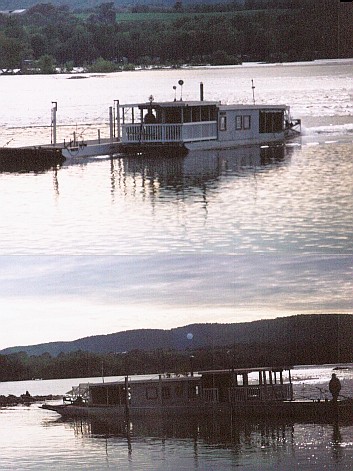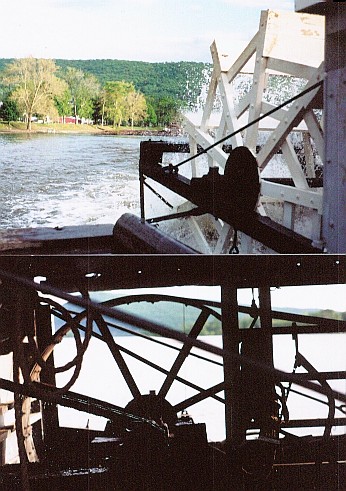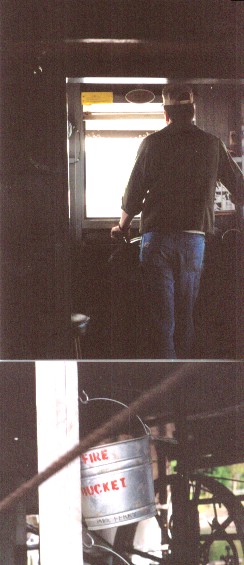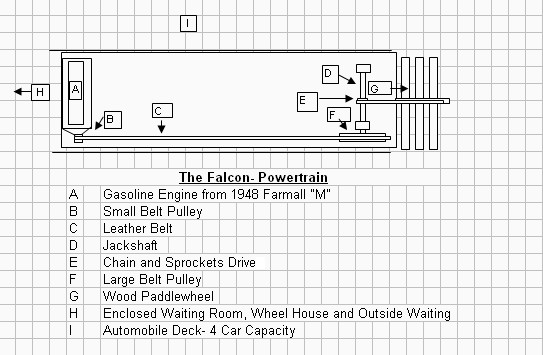Millersburg PA Paddlewheel Ferry
May 18, 2003
A Very Unofficial Site!
(see Railroutes of the Alleghenies).
 The ramp at Millersburg includes this sign that states the first poled ferry at this location started in 1825. A powered paddlewheel ferry began freight and passenger operations in 1873. The ferry acted as an unofficial extention of the railroad and canal on the east shore. The ferry also took advantage of the more pristine west shore in the coal washing days, operating a successful grove and camping area. As might be expected, the ferry has been the center of fights, squabbles, intrigue, cheating and all other manner of bad human behavior over the years, but the point is that it survived! See the complete history in a link below. One of the few ferries still operating on the Susquehanna, this ferry is believed to be the last wooden paddlewheel ferry in the US. The operations at the landing includes a door on an open frame. When you want to signal the boat to pick you up, you close the white door. The bottom photo shows the other ferry boat of the fleet docked at Millersburg.
The ramp at Millersburg includes this sign that states the first poled ferry at this location started in 1825. A powered paddlewheel ferry began freight and passenger operations in 1873. The ferry acted as an unofficial extention of the railroad and canal on the east shore. The ferry also took advantage of the more pristine west shore in the coal washing days, operating a successful grove and camping area. As might be expected, the ferry has been the center of fights, squabbles, intrigue, cheating and all other manner of bad human behavior over the years, but the point is that it survived! See the complete history in a link below. One of the few ferries still operating on the Susquehanna, this ferry is believed to be the last wooden paddlewheel ferry in the US. The operations at the landing includes a door on an open frame. When you want to signal the boat to pick you up, you close the white door. The bottom photo shows the other ferry boat of the fleet docked at Millersburg.
 The Susquehanna is a mile wide at this point, so it takes a while to figure out the you have been spotted and the boat is on the way. The top photo shows the boat approaching Millersburg and steaming at full speed. The bottom photo shows the crew deftly swinging the boat around at the Millersburg landing.
The Susquehanna is a mile wide at this point, so it takes a while to figure out the you have been spotted and the boat is on the way. The top photo shows the boat approaching Millersburg and steaming at full speed. The bottom photo shows the crew deftly swinging the boat around at the Millersburg landing.
 The auto deck has capacity for four cars. The ferry claims a capacity of 50 people. The front view of the Falcon shows the outside passenger waiting area. The inside waiting room features a potbellied stove, the smokestack is seen near amidship. The utilitarian Falcon features lights, a bell and a horn, all functional and no fluff.
The auto deck has capacity for four cars. The ferry claims a capacity of 50 people. The front view of the Falcon shows the outside passenger waiting area. The inside waiting room features a potbellied stove, the smokestack is seen near amidship. The utilitarian Falcon features lights, a bell and a horn, all functional and no fluff.
 No fake paddlewheel is used on these ferry boats. The powertrain reminds one of builders more familiar to farming than riverboating. In fact, one could probably replicate one of these boats by visiting a good farm equipment junkyard. Owning a sawmill would be helpful, too, the boat is primarily a wooden superstructure. Apparently for proper weight distribution, the powertrain takes up considerable length, as attempted to show in the drawing below. When asked about a closer inspection, the captain said that passengers were not allowed in the engine room or the cellar. The cellar?...is this an attempt to fool the flatland touristers?
No fake paddlewheel is used on these ferry boats. The powertrain reminds one of builders more familiar to farming than riverboating. In fact, one could probably replicate one of these boats by visiting a good farm equipment junkyard. Owning a sawmill would be helpful, too, the boat is primarily a wooden superstructure. Apparently for proper weight distribution, the powertrain takes up considerable length, as attempted to show in the drawing below. When asked about a closer inspection, the captain said that passengers were not allowed in the engine room or the cellar. The cellar?...is this an attempt to fool the flatland touristers?
The pedigree of these boats go back to the Susquehanna coal dredges (enough coal was washed into the river from coal cleaning operations on some tributaries to make recovery of the fine coal sludge profitable), and even before that, to the ferry operations at Peach Bottom operated by the Peach Bottom Railroad.
 The captain controls the ferry from his wheelhouse. With his left hand on the wheel, the captain has his right hand on the throttle, a wooden spool that winds up a cable to the Farmall engine's carburetor. In the bottom photo we see a very practical way to deal with a fire. Besides this fire fighting equipment, the boats also have life preservers and a substantial anchor. The anchor would come in handy if the power gave out midstream. The oil pan gasket has a slight leak, and at full power, wisps of oil smoke issuing from the vintage "M" engine adds to experience of bygone days when transportation was full of sights, sounds and smells.
The captain controls the ferry from his wheelhouse. With his left hand on the wheel, the captain has his right hand on the throttle, a wooden spool that winds up a cable to the Farmall engine's carburetor. In the bottom photo we see a very practical way to deal with a fire. Besides this fire fighting equipment, the boats also have life preservers and a substantial anchor. The anchor would come in handy if the power gave out midstream. The oil pan gasket has a slight leak, and at full power, wisps of oil smoke issuing from the vintage "M" engine adds to experience of bygone days when transportation was full of sights, sounds and smells.
 Here is my recollection of the drive train
Here is my recollection of the drive train
Millerburg Ferry Official Site-Use "Back" to return to this page
Millerburg Ferry History- Use "Back" to return to this page
Rockville Bridge Rails Across the Susquehanna By Dan Cupper
Back to Cumberland Valley Railroad
Western Maryland Railway and Related Rail Links
Western Maryland Railway Yesterday and Today
World's Greatest Railroads!





